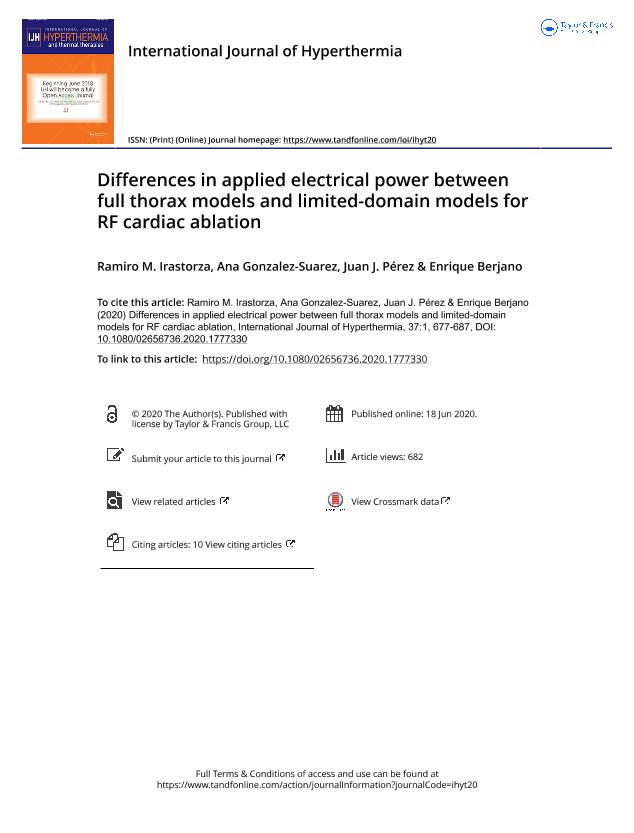Mostrar el registro sencillo del ítem
dc.contributor.author
Irastorza, Ramiro Miguel

dc.contributor.author
González Suárez, Ana
dc.contributor.author
Pérez, Juan J.
dc.contributor.author
Berjano, Enrique
dc.date.available
2022-03-29T20:42:55Z
dc.date.issued
2020-06-18
dc.identifier.citation
Irastorza, Ramiro Miguel; González Suárez, Ana; Pérez, Juan J.; Berjano, Enrique; Differences in applied electrical power between full thorax models and limited-domain models for RF cardiac ablation; Informa Healthcare; International Journal Of Hyperthermia; 37; 1; 18-6-2020; 677-687
dc.identifier.issn
0265-6736
dc.identifier.uri
http://hdl.handle.net/11336/154024
dc.description.abstract
Purpose: Most modeling studies on radiofrequency cardiac ablation (RFCA) are based on limited-domain models, which means the computational domain is restricted to a few centimeters of myocardium and blood around the active electrode. When mimicking constant power RFCA procedures (e.g., atrial fibrillation ablation) it is important to know how much power is absorbed around the active electrode and how much in the rest of the tissues before reaching the dispersive electrode.Methods: 3D thorax full models were built by progressively incorporating different organs and tissues with simplified geometries (cardiac chamber, cardiac wall, subcutaneous tissue and skin, spine, lungs and aorta). Other 2D limited-domain models were also built based on fragments of myocardium and blood. The electrical problem was solved for each model to estimate the spatial power distribution around the active electrode.Results: From 79 to 82% of the power was absorbed in a 4 cm-radius sphere around the active electrode in the full thorax model at active electrode insertion depths of between 0.5 and 2.5 mm, while the impedance values ranged from 104 to 118 Ω, which were consistent with those found (from 83 to 103 Ω) in a 4 cm radius cylindrical limited domain model.Conclusion: The applied power in limited-domain RFCA models is approximately 80% of that applied in full thorax models, which is equivalent to the power programed in a clinical setting.
dc.format
application/pdf
dc.language.iso
eng
dc.publisher
Informa Healthcare

dc.rights
info:eu-repo/semantics/openAccess
dc.rights.uri
https://creativecommons.org/licenses/by/2.5/ar/
dc.subject
CARDIAC ABLATION
dc.subject
COMPUTER MODEL
dc.subject
LIMITED-DOMAIN MODEL
dc.subject
RF ABLATION
dc.subject.classification
Otras Ingeniería Eléctrica, Ingeniería Electrónica e Ingeniería de la Información

dc.subject.classification
Ingeniería Eléctrica, Ingeniería Electrónica e Ingeniería de la Información

dc.subject.classification
INGENIERÍAS Y TECNOLOGÍAS

dc.title
Differences in applied electrical power between full thorax models and limited-domain models for RF cardiac ablation
dc.type
info:eu-repo/semantics/article
dc.type
info:ar-repo/semantics/artículo
dc.type
info:eu-repo/semantics/publishedVersion
dc.date.updated
2021-04-23T19:06:12Z
dc.identifier.eissn
1464-5157
dc.journal.volume
37
dc.journal.number
1
dc.journal.pagination
677-687
dc.journal.pais
Reino Unido

dc.journal.ciudad
Londres
dc.description.fil
Fil: Irastorza, Ramiro Miguel. Universidad Nacional Arturo Jauretche; Argentina. Consejo Nacional de Investigaciones Científicas y Técnicas. Centro Científico Tecnológico Conicet - La Plata. Instituto de Física de Líquidos y Sistemas Biológicos. Universidad Nacional de La Plata. Facultad de Ciencias Exactas. Instituto de Física de Líquidos y Sistemas Biológicos; Argentina
dc.description.fil
Fil: González Suárez, Ana. National University Of Ireland Galway.; Irlanda
dc.description.fil
Fil: Pérez, Juan J.. Universidad Politécnica de Valencia; España
dc.description.fil
Fil: Berjano, Enrique. Universidad Politécnica de Valencia; España
dc.journal.title
International Journal Of Hyperthermia

dc.relation.alternativeid
info:eu-repo/semantics/altIdentifier/url/https://www.tandfonline.com/doi/full/10.1080/02656736.2020.1777330
dc.relation.alternativeid
info:eu-repo/semantics/altIdentifier/doi/http://dx.doi.org/10.1080/02656736.2020.1777330
Archivos asociados
